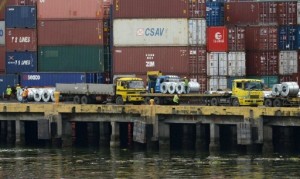
Shipping containers of Philippine products for export sit stacked along the docks of the international container port in Manila on Sept. 11, 2012. Exports climbed 16.5 percent in December to $3.97 billion, the biggest rise in three months. AFP PHOTO/JAY DIRECTO
Philippine exports in January dropped for the first time in five months as demand for the country’s electronics products remained weak, the National Statistics Office reported Tuesday.
That month, total merchandise exports declined by 2.7 percent year on year to $4.01 billion due to slower sales of electronics and other items.
In particular, outbound shipments of electronics contracted 31.9 percent, the steepest drop in 14 months, the statistics office said on Tuesday.
The value of electronics exports also slumped to $1.47 billion, the lowest since February 2009 when the sector shipped out $1.35 billion.
But according to the National Economic and Development Authority (Neda), semiconductor exports are expected to grow despite its 23.2 percent decline in Jan. 2013.
“The annual gain of worldwide chip sales recorded suggests an improvement for the industry for the year,” said Arsenio M. Balisacan, socioeconomic planning secretary and Neda’s director general.
In 2012, electronics shipments contracted by 5.2 percent.
Overall exports prospects would be even better if the United States and Europe could sustain their recovery throughout the year, Dr. Cid L. Terosa of the University of Asia and the Pacific said in a text message.
“Moreover, more orders for semiconductor equipment may be expected as indicated by the upward trend of book-to-bill ratios in major electronics production hubs like the US and Japan,” Balisacan said.
The Semiconductor Industry Association (SIA) recorded an annual gain of 3.8 percent in worldwide chip sales.
Lower overseas sales of semiconductors (-23.2 percent), electronic data processing (-72.7 percent), copper metal (-78.9 percent), communication radar (-63.7 percent), consumer electronics (-53.4 percent) and machinery and transport equipment (-3.4 percent) accounted for the contraction of manufactures (-5.8 percent) during the month.
“The decline in semiconductors exports may be partly attributed to lower value of shipments to Singapore, China, the US and Japan, which accounted for more than half [51.6 percent] of the country’s semiconductor revenues,” said Balisacan.
Other manufactured exports that also declined year on year during the period were garments (-41.7 percent), machinery and transport equipment (-3.4 percent), miscellaneous manufactures (-13.9 percent), textile yarns/fabrics (-9.2 percent), iron and steel (-6.1 percent), and baby carriage and toys (-6.1 percent).
However, total agro-based exports were up by 33.3 percent ($388.9 million) in January 2013, from the $291.7 million posted in the same month last year.
“It should be noted that, despite the damage caused by Typhoon Pablo during the latter part of 2012, exports of bananas sustained robust growth in January,” Balisacan said.
Also, petroleum exports grew by 53.9 percent in January 2013 to $72.8 million from $47.3 million in the same period of 2012.
Japan was the top market of Philippine products, accounting for 19.2 percent of total receipts. Korea followed with a 14.1-percent share, the US with 13 percent, China with 10.5 percent, and Hong Kong with 8.2 percent.
Most Asian exporters are confronting uneven export growth as recovery slackens in some key economies such as the eurozone and the United States, to which the bulk of the region’s technology shipments go.
But some are optimistic that the trade picture will be better in the coming months.—With a report from Reuters